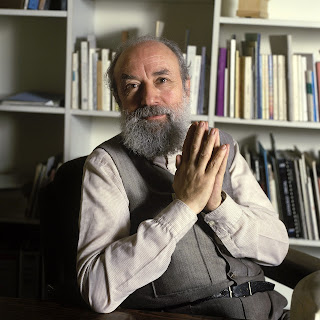33. Michel Butor
“All these monuments are naturally of a dazzling whiteness.” -Michel Butor (translated by Richard Howard)
Construction on the Jefferson Memorial, the 80,000 square foot classical revival structure built on the shores of the Potomac River, began in 1938 and was completed five years later. The centerpiece of the memorial is a 19-foot bronze sculpture of the third president, standing on a pedestal in the middle of the room and surrounded by excerpts from his most memorable writings. Among the quotes, one, located on the northeast wall of the monument’s interior, condenses and combines two passages taken from Notes on the States of Virginia (1785) and his Autobiography (1821): “Commerce between master and slave is despotism. Nothing is more certainly written in the book of fate than that these people [slaves] are to be free.”
In 1959, French novelist Michel Butor visited the United States, spending six months in the country, driving across a national highway system then in the process of being constructed and absorbing the colors, sounds, and textures of the nation. Three years later the literary upshot of his travels was released into the world. The resultant text Mobile is a sweeping collage of place names, road signs, descriptions of flora and fauna, newspaper clippings, press releases, Salem witch trial transcripts, original satirical passages, and quotations from any number of literary and sub-literary texts, painting a portrait of the U.S. as a place of space, variety, and more than its share of troubling attitudes and events.
Among the literary quotations, Butor cites a different passage from Jefferson’s Notes on the State of Virginia: “Comparing them by their faculties of memory, reason, and imagination, it appears to me that in memory [Black Americans] are equal to the whites; in reason much inferior… and that in imagination they are dull, tasteless, and anomalous.”
Construction of the Washington Monument, today the world’s tallest obelisk and for five years in the late 19th century the world’s tallest structure, began in 1848 and, due to the Civil War and a lack of adequate funding, was not fully completed until 1888. The Lincoln Memorial, located across the Reflecting Pool from the Monument, faced a less tumultuous construction process. It was dedicated in 1922.
The Robert E. Lee Monument in Richmond, Virginia, the former capital of the Confederacy, was erected in 1890. The statue depicts Lee atop his horse, the whole sculpture situated on top of a tall stone base. It has proved controversial since its construction and is now scheduled for removal, pending legal challenges.
According to Butor, in one of his satirical passages, the
name Washington “refers to a skillful general who assumed command of operations
during the War of Independence, and was quickly accorded divine status.” Of his
monument, Butor writes, “in the city of Washington itself, it is nonetheless
felt that any human figuration would be almost blasphemous, and the god is
represented in the form of an enormous obelisk.”
In 2007, the American Institute of Architects conducted a study to determine “America’s Favorite Architecture,” first polling their own members and then the public. The Jefferson Memorial placed fourth, with the Lincoln Memorial coming in at seventh and the Washington Monument ranking twelfth. The list was topped by the Empire State Building.
On June 15th, 2020, James Stout offered up a
helpful primer on “How to Topple a Statue Using Science,” in Popular
Mechanics. “The force required to pull down a statue isn’t as great as you
think,” the article begins.
“On the highway a Lincoln whose radio is blaring ‘Illinois’ (speed limit 65 miles),” Butor observes.
For the average statue, Stout recommends a team of 70 people. While it should only take 35 people to drag a 3,500 pound structure (the average weight of a public statue), he calculates that it would take twice that many people to pull it down.
“They did not try to know this country,” Butor writes of the first Europeans in America, “they had no desire to settle here. They were content with temporary habitations. They wanted only to survive and grow rich in order to be able to return.”
Stout’s article proving controversial, Popular Mechanics appended a disclaimer: “This article is being presented only to describe the physics and mechanics of removing statues. Popular Mechanics is not encouraging anyone to remove any statues.”
“Meanwhile,” Butor continues, “until this triumphal return took place, why not reconstitute a new Europe, effacing as much as possible this continent that received but alarmed us?”
On June 1, 2020, a statue of Robert E. Lee in Montgomery, Alabama was toppled by protestors.
On June 19, two statues at the North Carolina State Confederate Monument were also removed by protestors.
That same day, a statue of Confederate officer Albert Pike was toppled and set on fire in Washington, D.C.
On June 29, in Frederick, Maryland, a statue of a Confederate soldier was removed and beheaded.
And on July 5, a statue of Frederick Douglass in Rochester, NY was taken from its base and thrown in a nearby gorge by unknown assailants. Pundits on the right were quick to assign blame to Marxists and anarchists who supposedly could not differentiate between Douglass and Confederate leaders in their zest for destruction.
Stout concludes his article with some safety advice, “Just make sure you use the proper protective equipment and look to see that nobody is underneath the statue when it falls.”
During the recent protests following the murder of George Floyd, a group of National Guardsmen assembled in front of the Lincoln Memorial to protect it. Decked out in full battle gear, arrayed in neat rows, the soldiers were captured in a photo that quickly went viral. According to the Washington Post, “the image of troops arrayed on the steps of Lincoln Memorial only added to the sense of crisis and civil disintegration,” adding that “the D.C. Guard looked not like protecting sentinels, but possessive custodians.”
“The most important religious practice of the American Europeans is the pilgrimage to the sacred city of Washington, where the principal temples and the essential government organizations are located,” writes Butor, again in satirical mode.
“The sound of wind in the night,” Butor writes, straightfaced.
A joke: “The magical power of these monuments is such that many American Europeans, even cultivated ones, attribute architectural qualities to them.”
“A shifting of dust in the wind…
The roof cracks in the night…”
“The three divinities Washington, Jefferson and Lincoln are the most important in the American pantheon,” Butor writes.
“The sound of wind in the night…
Not a sigh in this night, except for the wind.”



Comments
Post a Comment